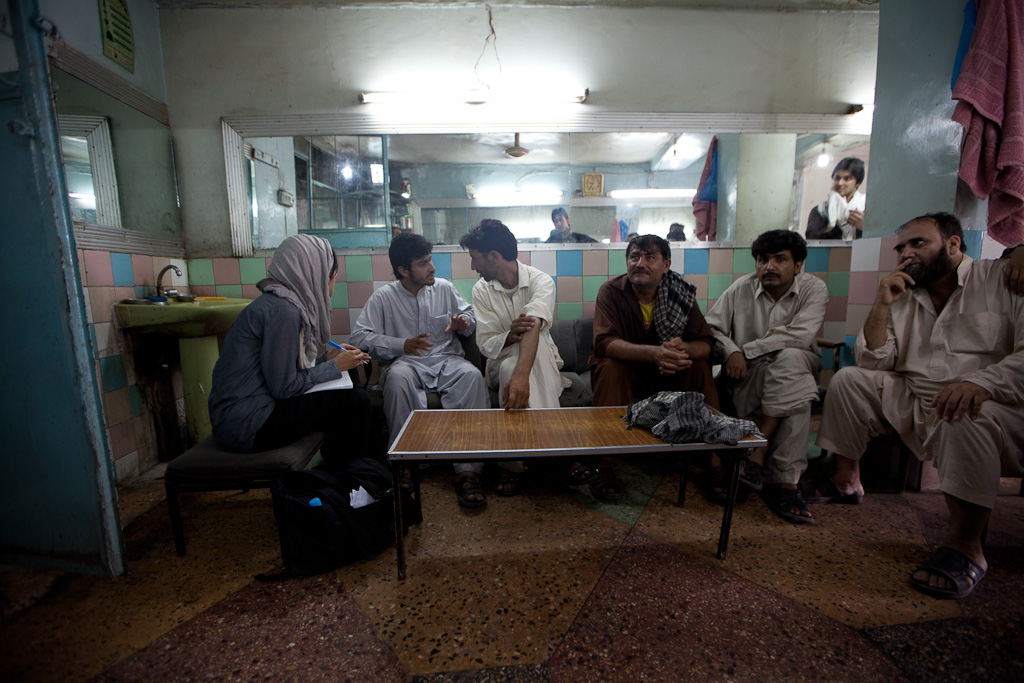From the Afghanistan Mobile Money research:
Print-ready photo resolutions also available – ping hei at janchipchase dot com to request copies.
One would expect mobile money services to be well suited to Afghanistan: low levels of fixed banking infrastructure; rising mobile penetration; and a safer, cheaper, more convenient way of transferring money – especially one that removes the likelihood of graft. It all points to a rising adoption.
However local operator Roshan and other network operators must overcome numerous non-trivial consumer barriers to adoption including: textual, mobile and financial illiteracy; a general distrust of institutions compounded by the well established Hawala agent network; a general distrust of non-tangible assets; and the chicken & egg challenge of investing in an agent network without sufficient customers – and customers less willing to experiment with the service without there being a strong agent network. Furthermore in a county with considerable graft, to the wrong eyes – a legitimate commission may seem like an outstretched hand. Expect mobile literacy to rise over time – as people purchase their 3rd/4th/5th mobile phone; and similarly as people grow to rely on mobile services expect to see increasing trust in the operators.
Those of you interested in the broader landscape should read CGAP’s Microfinance Blog; the GSMA’s Money for the Unbanked blog; and the Bill & Melinda Gates Foundation’s Financial Services for the Poor site. One chapter in Porfolio’s of the Poor is a good primer for newcomers to this space, and for local colour check out the Afghanistan thread.
It’s worth noting that statistics for banking penetration and mobile penetration are difficult to tie down. CGAP calculates that there are 83 bank accounts per 1,000 members of the population although many of these will have multiple accounts to increase the likelihood that they will win with Bakht or lottery accounts (the principles of Sharia law forbid interest – but accounts numbers with a minimum deposit can be entered into a prize draw to win prizes such as money, cars or even an apartment). Similarly mobile penetration stats are difficult to come by – but whatever the number assume that anyone who can afford to will own and maintain 2 or 3 SIM cards/phones simultaneously – it’s simply good practice to reduce call costs between networks; to extend better coverage and/or to separate work from personal life.
With thanks to the extended team for pulling it all together – Enayat Najafizada, Airokosh Faizi, Mokhtar Hajji, Hamid Tasal, Farida Rustamkh, Sam Martin, Tom Manning, Kristina Loring and of course Panthea Lee. Zahir Khoja, Shainoor Khoja and Evan Decorte at Roshan were interviewed to better understand the mobile money landscape (but had no input into the report itself); Mark Pickens helped with decoding actual bank account/subscriber numbers.
Related: research into illiteracy and mobile phone use.

14 Trackbacks
[…] This post was mentioned on Twitter by Future Perfect, UX Feeder. UX Feeder said: Future Perfect: Mobile Money Afghanistan: From the Afghanistan Mobile Money research: Download Main Report: M… http://bit.ly/fMDyNT […]
[…] Go here to see the original: Future Perfect » Mobile Money Afghanistan […]
[…] Read the rest here: Future Perfect » Mobile Money Afghanistan […]
[…] Future Perfect » Mobile Money Afghanistan […]
[…] Future Perfect » Mobile Money Afghanistan […]
[…] Future Perfect » Mobile Money Afghanistan […]
[…] Future Perfect » Mobile Money Afghanistan […]
What will be the next big thing after Facebook and Twitter? Why?…
regarding this trend, I went to a very interesting meetup @frogdesign yesterday, you should be interested in this research on mobile payment http://janchipchase.com/2011/02/mobile-money-afghanistan-2/…
[…] Future Perfect » Mobile Money Afghanistan […]
[…] Future Perfect » Mobile Money Afghanistan […]
[…] This report was released last week on the mobile money service M-Paisa in Afghanistan, provides some intriguing insights on issues faced by Afghanis and the mobile banking services rapidly emerging in their country. […]
[…] This report was released last week on the mobile money service M-Paisa in Afghanistan, provides some intriguing insights on issues faced by Afghanis and the mobile banking services rapidly emerging in their country. […]
[…] This past summer, Jan Chipchase, Frog Design’s Executive Creative Director for Global Insights, ventured to Afghanistan to learn how the mobile money business is growing–and not growing–in the country. FastCompany.com had the chance to speak with Chipchase to learn more about the findings presented in his just-unveiled report, Mobile Money Afghanistan. […]
[…] be posting a selection of the 170 creative commons photos from the Afghanistan mobile money project over the coming weeks. This: manual labourers under the Roshan cell tower, in Dehdadi, a small […]